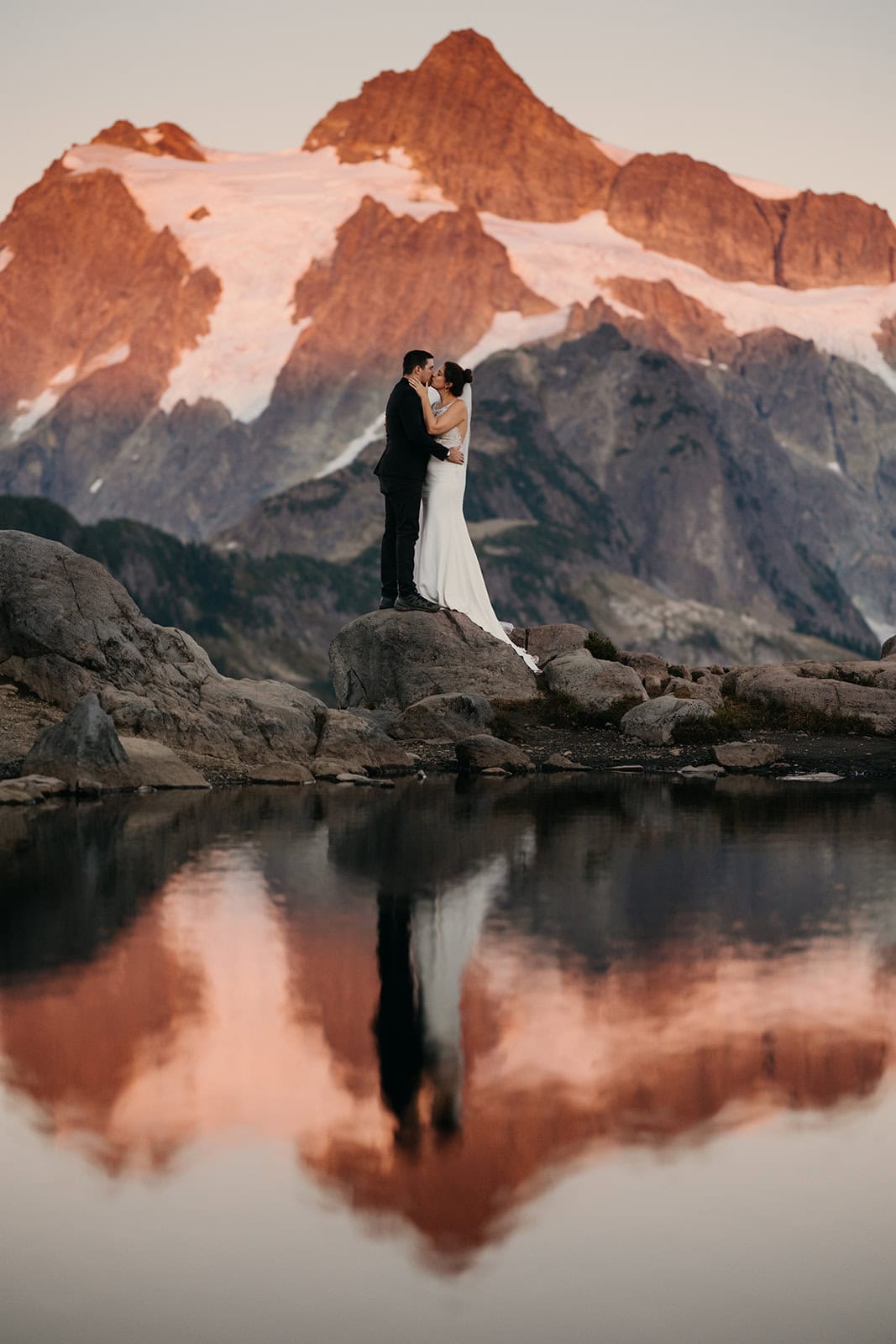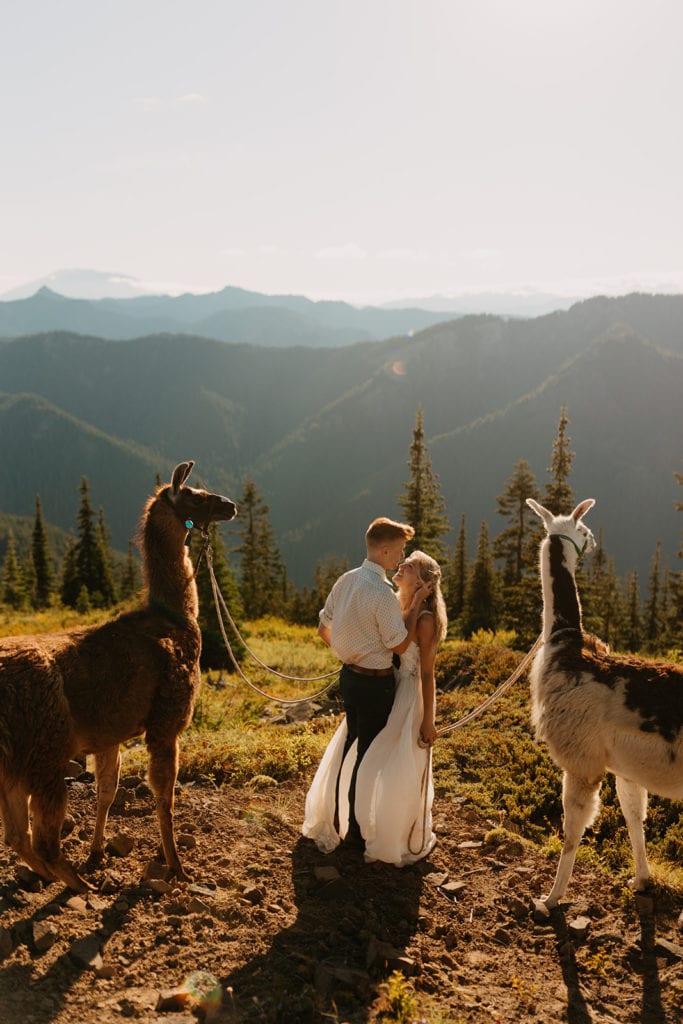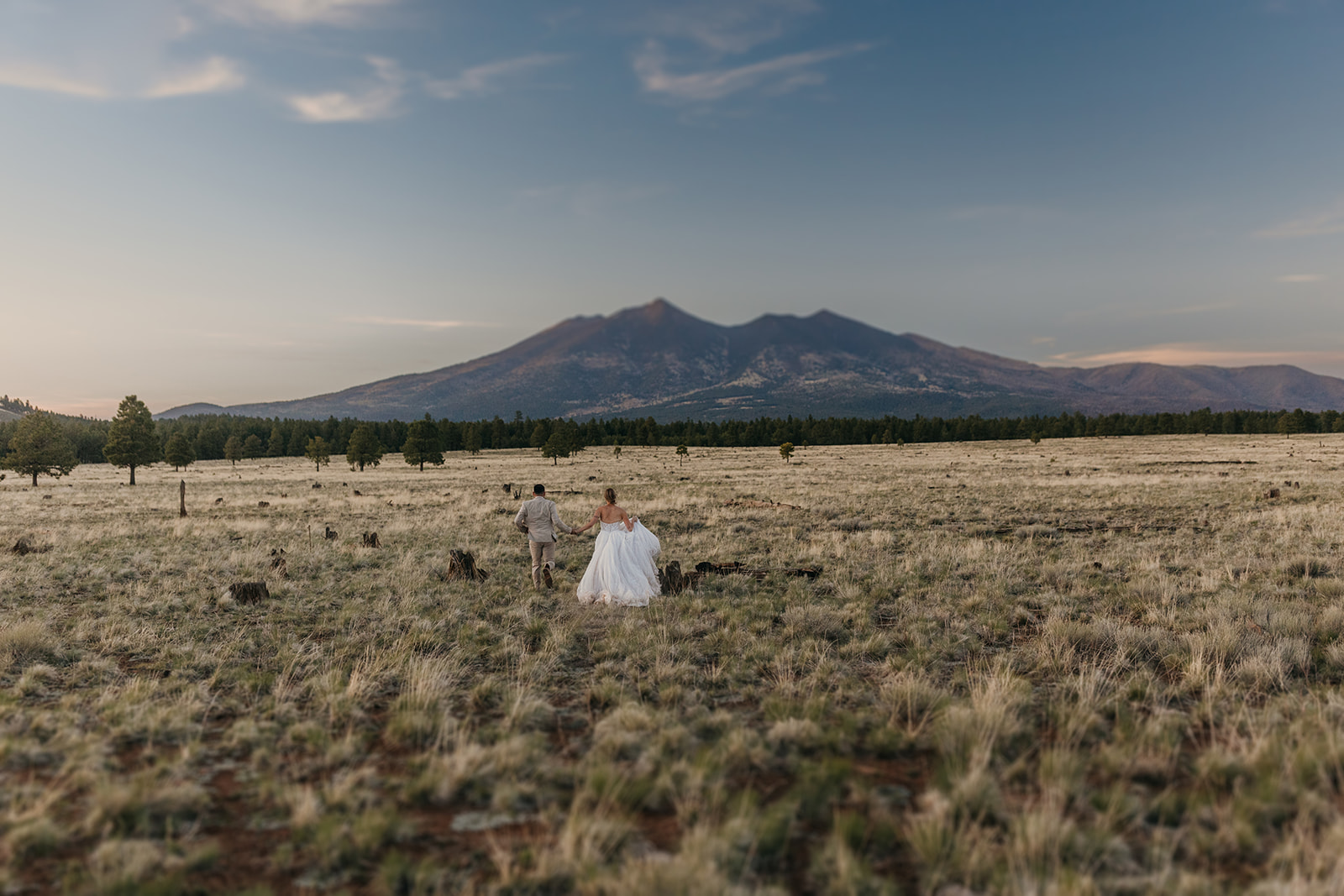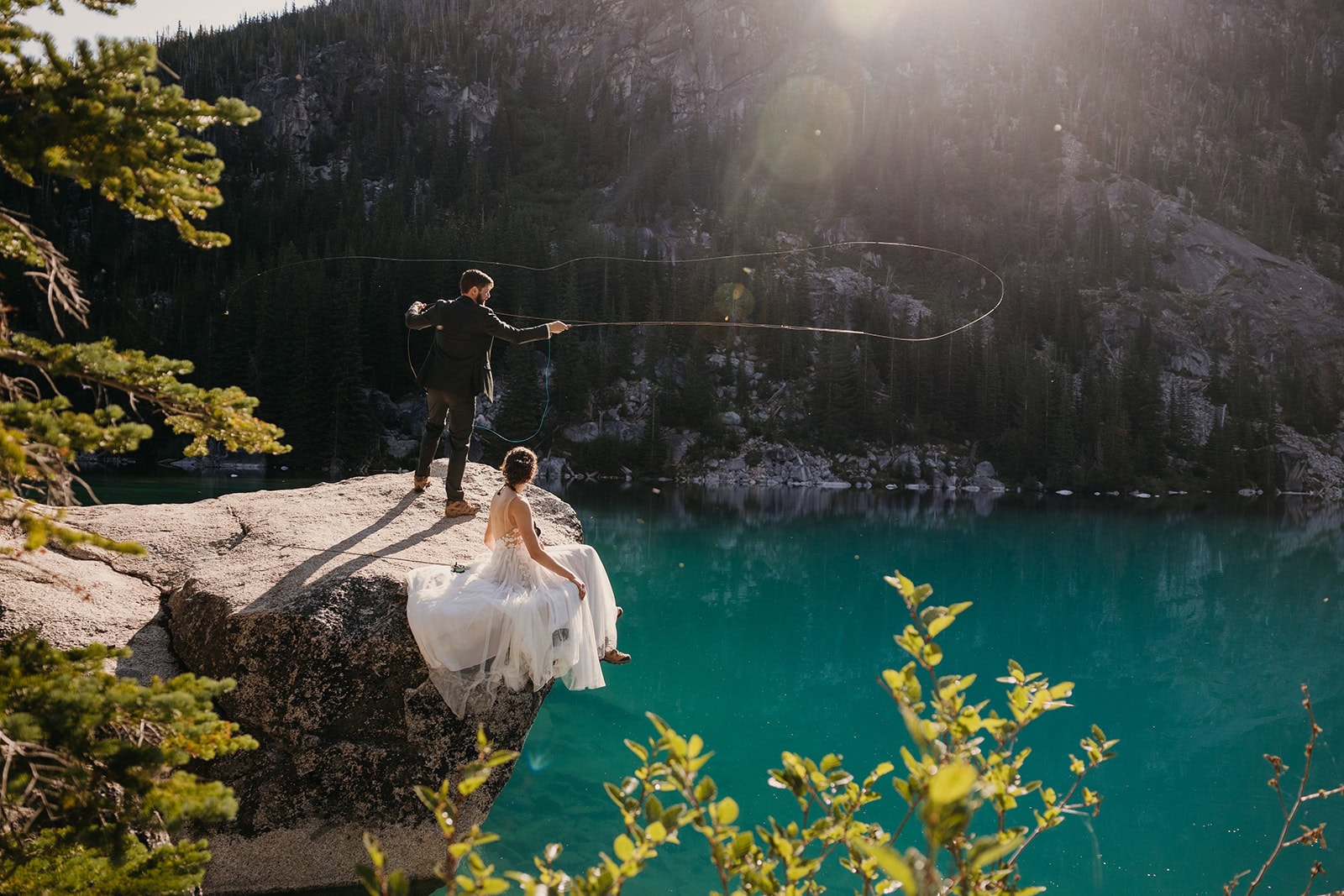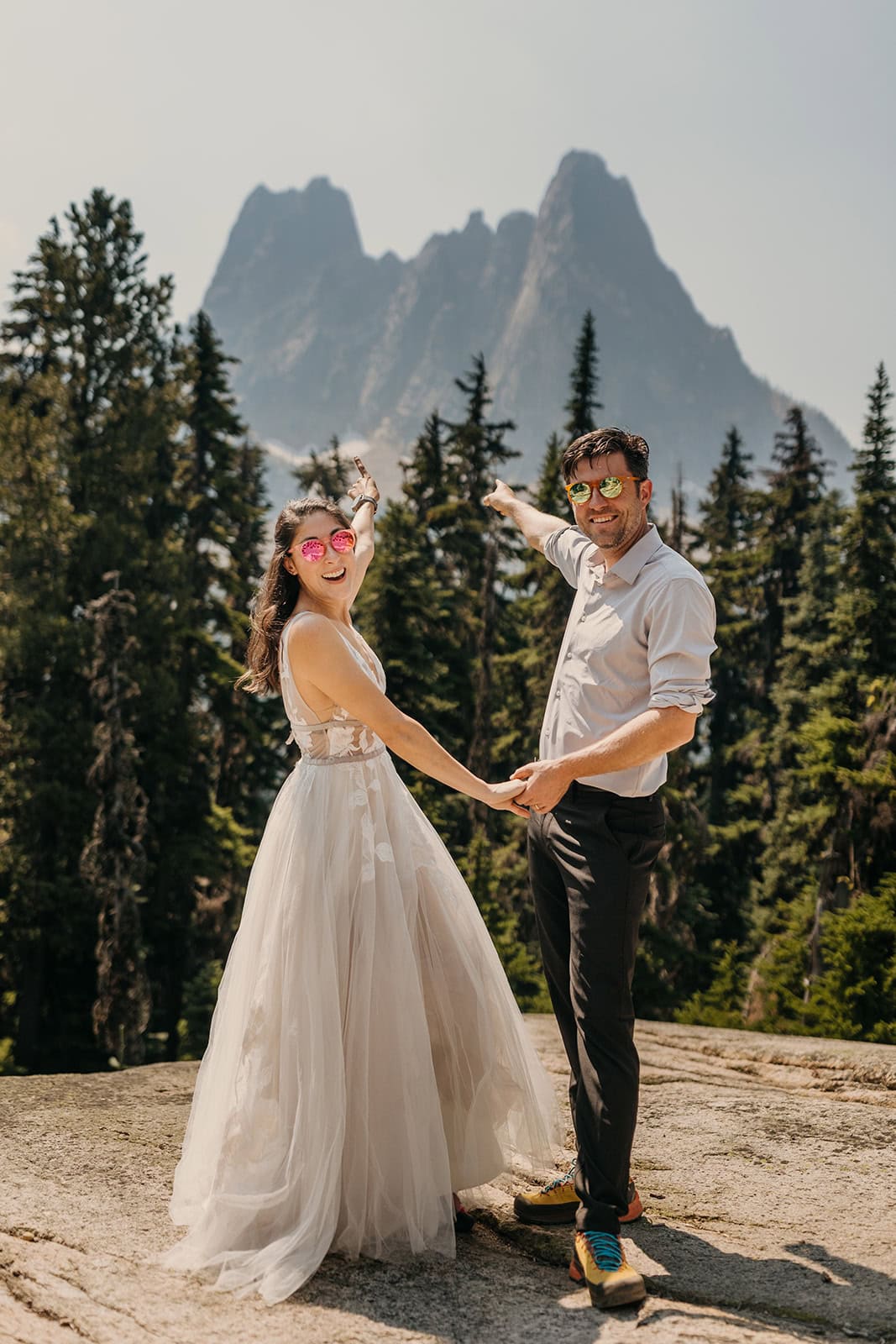3 Days in Moab: 9 Must-See Spots and Hidden Gems
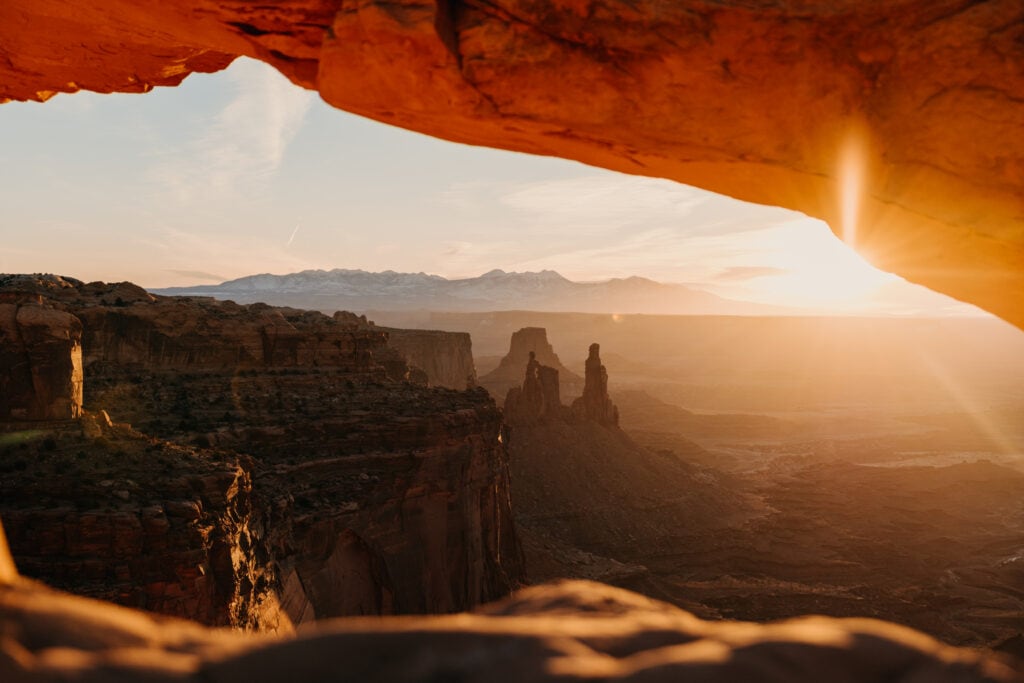
Welcome to Moab, a paradise for outdoor enthusiasts and nature lovers. Nestled in the heart of Utah’s red rock country, this small town packs a big punch when it comes to adventure. With its stunning landscapes, world-class national parks, and endless opportunities for exploration, Moab has become a must-visit destination for those seeking to experience the raw beauty of the American Southwest.
Planning a trip to Moab? Three days in this outdoor playground gives visitors a chance to see the highlights and uncover some hidden gems. From the iconic Delicate Arch in Arches National Park to the breathtaking views at Island in the Sky in Canyonlands, Moab offers an unforgettable journey through nature’s masterpieces. This guide will help you make the most of your time, whether you’re hiking to Mesa Arch, marveling at Balanced Rock, or taking in the panoramic vistas at Grand View Point Overlook. Get ready to embark on an adventure that will leave you dreaming up your next trip to this remarkable corner of Utah.
The activities surrounding these three days are centered around sunrise, mid-day and then sunset. You will need to be sure that you’re adjusting the plan as needed for meals, relaxation, and shopping. At the end, we’ll tell you our favorite shops and more hidden gems, but the outdoors of Moab is why you’re visiting right?! So we wanted to be sure you don’t miss these 9 must-see places.
The reality is that Moab is such a vast landscape with a huge variety of places to see and things to do. So the disclosure here is if you prefer a morning of activities and then relaxing the rest of the day, you have the option to take any chunk of each daily itinerary and explore just that section, saving the rest for another trip. But if you’re anything like us, then buckle in and get ready for a jam-packed 3 days in Moab itinerary!
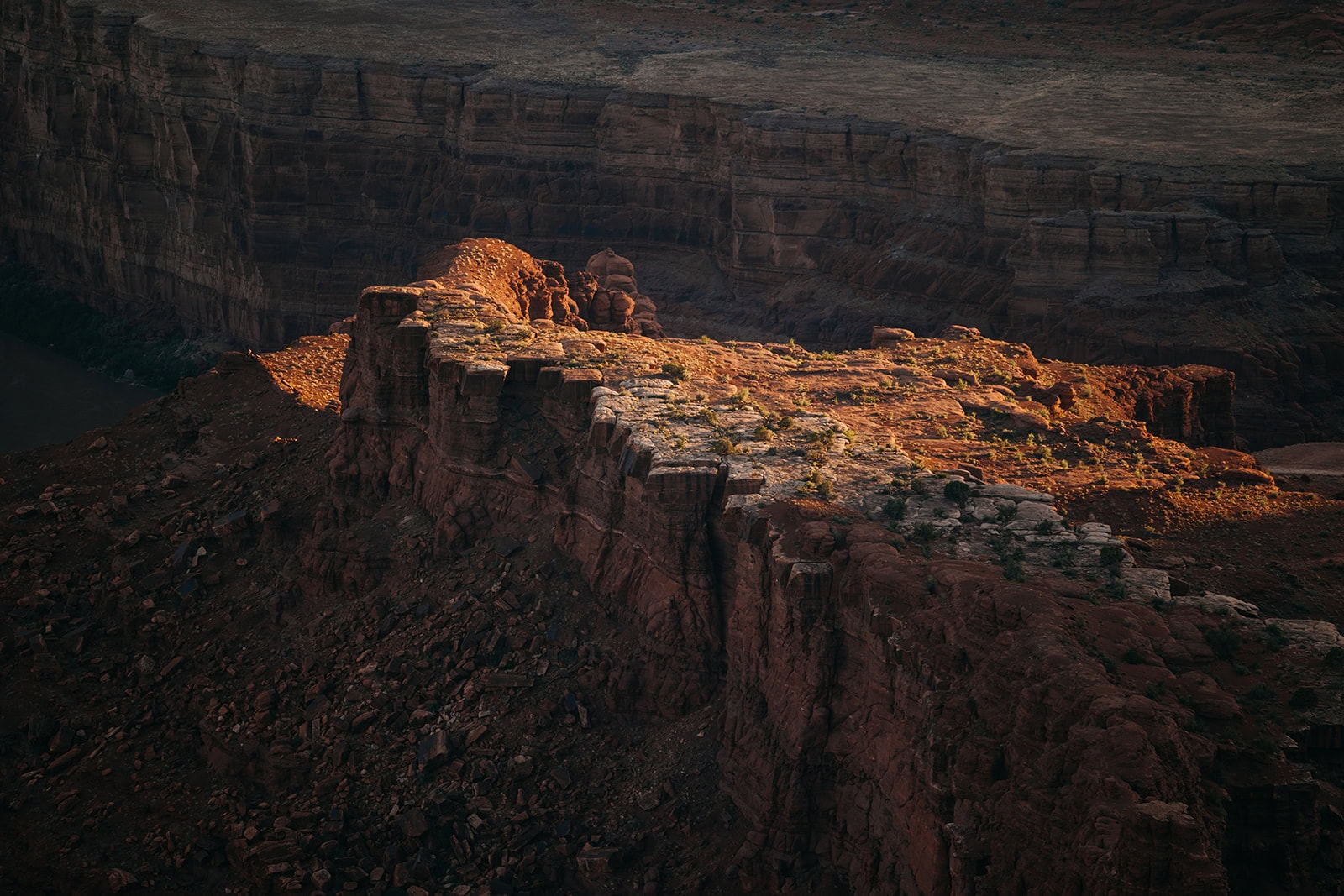
Planning Your 3-Day Moab Itinerary
Best Time to Visit
The ideal seasons to experience Moab’s outdoor wonders are spring (March to early May) and fall (September to October). During these months, the weather is pleasant, and the trails beckon adventure seekers. However, these periods also see the highest visitor numbers.
For those who don’t mind the heat, summer can be an excellent time to visit. The long days and higher temperatures tend to scare off some crowds, allowing for a more intimate experience with nature. Early risers and twilight adventurers can still enjoy outdoor activities during the summer months.
Winter in Moab offers a unique perspective on the desert landscape. With average highs of about 44 degrees in December and January, it suits some hikers and mountain bikers just fine. However, nights can be quite cold, dipping into single digits. Winter also provides the most solitude for those seeking a peaceful escape.
For those looking to avoid crowds while still enjoying mild weather, February and November can be sweet spots. These months offer the chance to see rock towers, canyons, and arches adorned with a sparkling coat of snow, creating a magical desert winter wonderland.
Getting There
Moab’s remote location adds to its charm, but getting there requires some planning. Fortunately, several airlines make the journey accessible:
1. United Airlines: Connects through Denver to Moab (CNY)
2. Delta Airlines: Connects through Salt Lake City
3. American Airlines: Flies into Grand Junction (GJT), Colorado
For those preferring a more convenient option, flying directly into Moab (CNY) through Denver or Salt Lake City is now possible. The Moab Canyonlands Airport (CNY) is small, with just one gate, making for a quick and easy arrival experience.
Alternatively, Grand Junction, Colorado (GJT) serves as an excellent gateway to Moab. The airport is easy to navigate, and the two-hour drive to Moab is scenic and enjoyable. Salt Lake City International Airport is another option, though it’s a longer four-hour drive to Moab.
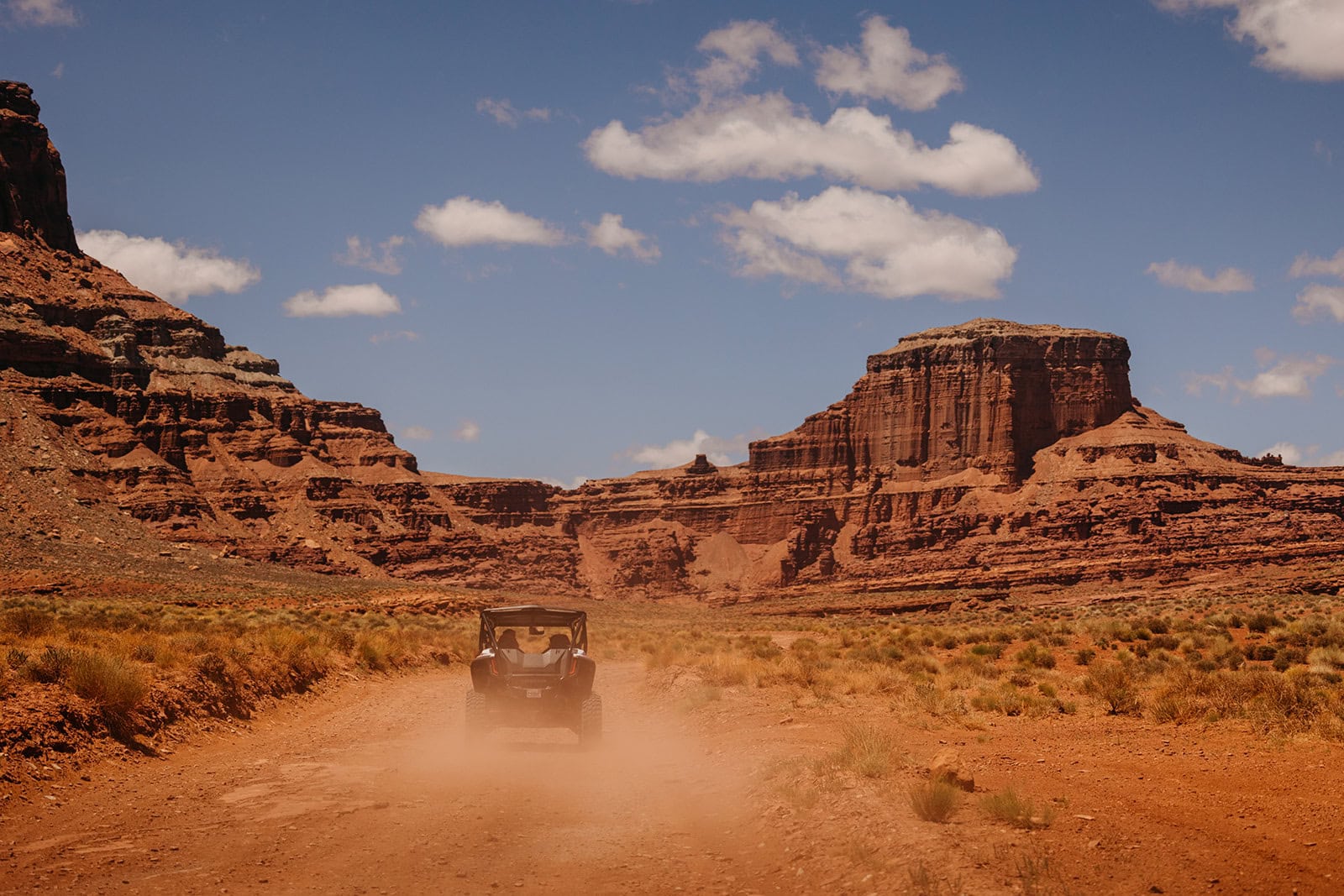
What to Pack
Packing for Moab requires careful consideration of the desert environment. Here’s a list of essentials:
- Layered clothing: Weather can change rapidly, so bring moisture-wicking base layers, mid-layers, and outer layers for protection against various condiions.
- Hiking boots: Waterproof, over-ankle boots are ideal for keeping feet dry and avoiding blisters
- Sun protection: Pack a sun hat, sunglasses, and high-SPF sunscreen.
- Hydration gear: Bring a hydration pack or reusable water bottles with at least 2 liters capacity. Water sources can be limited or non-existent depending on the location
- Daypack: A 30-liter pack with chest and waist straps is recommended for carrying essentials.
- Hiking Poles: Optional but useful for variable terrain and downhill hiking.
- First-aid kit: Include personal medications, blister care, and other essentials.
Remember to pack appropriate clothing for the season you’re visiting. In winter, bring warm layers and gloves, while in the summer, focus on lightweight, breathable clothing that offers sun protection.
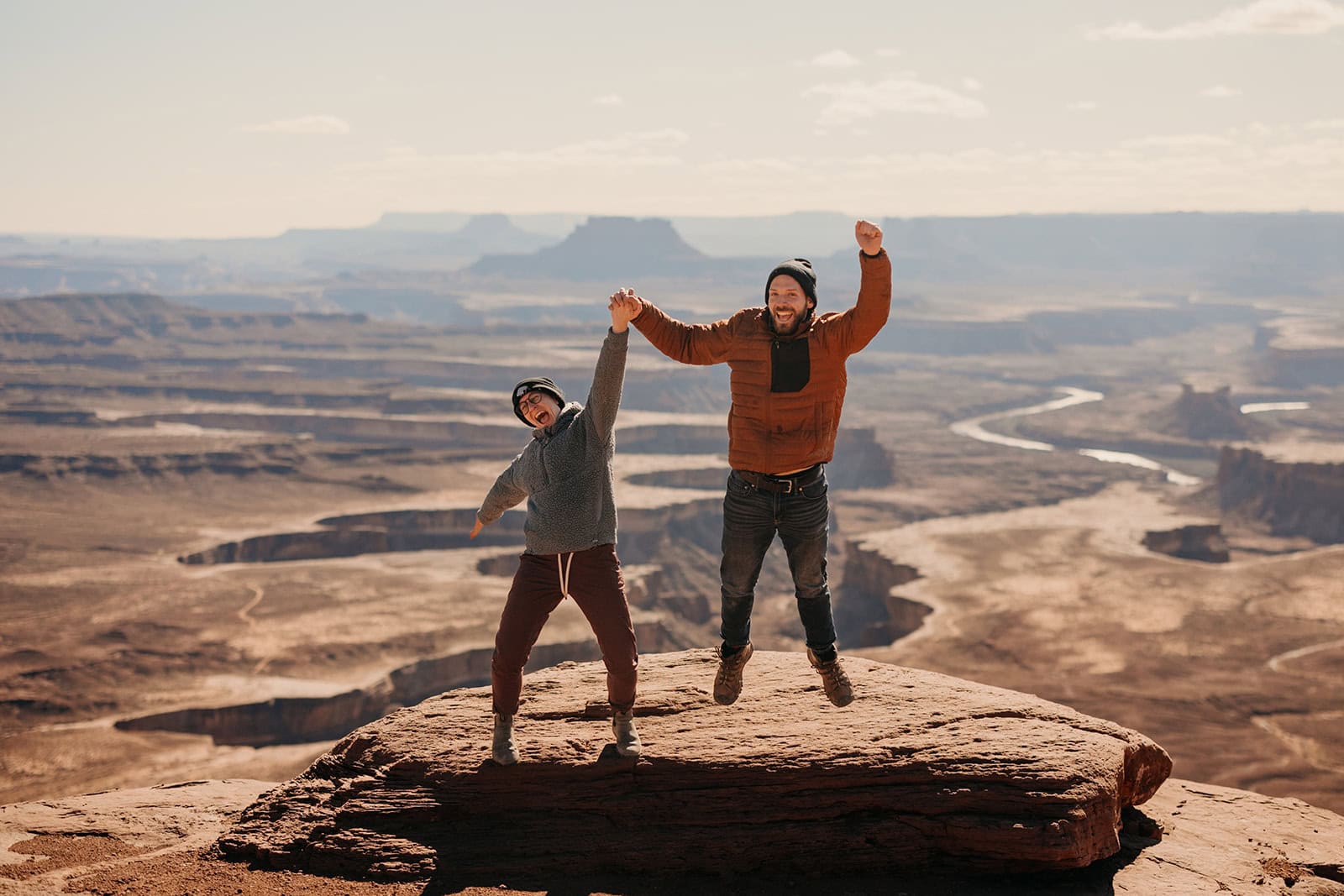
Day 1: Arches National Park Highlights
The first day of the Moab adventure begins with an early start to explore the wonders of Arches National Park. This iconic park is home to over 2,000 natural stone arches and countless other remarkable rock formations that will leave visitors in awe.
A very important note: During peak season (April 1st – October 31st), Arches National Park has a permitted entry system. This can be avoided by driving in very early or very late. Be sure that you’re aware of this when making your travel plans.
Sunrise at Delicate Arch
To kick off the day, adventurers should head to the famous Delicate Arch for a breathtaking sunrise experience. This 46-foot-high and 32-foot-wide free-standing arch is not only the largest in the park but has also become a globally recognized symbol of Utah’s natural beauty.
The hike to Delicate Arch is a 2.9-mile round trip with 480 feet of elevation gain. Starting before dawn has several advantages:
- Cooler temperatures and no risk of sun exposure
- Fewer crowds, allowing for a more peaceful experience
- Easier parking at the Wolfe Ranch lot
Hikers should be prepared with headlamps and warm layers, as the trail can be challenging to navigate in the dark. The path crosses sandstone rock faces, and hikers should follow the cairns (rock piles) set up by rangers to stay on track.
Upon reaching the arch, visitors can witness the stunning spectacle of the sun rising over the desert landscape, casting a warm glow on the iconic formation. After sunrise, there’s time to explore the area and even capture photos under the arch when the crowds have thinned.
Check out the All Trails link here for Delicate Arch!
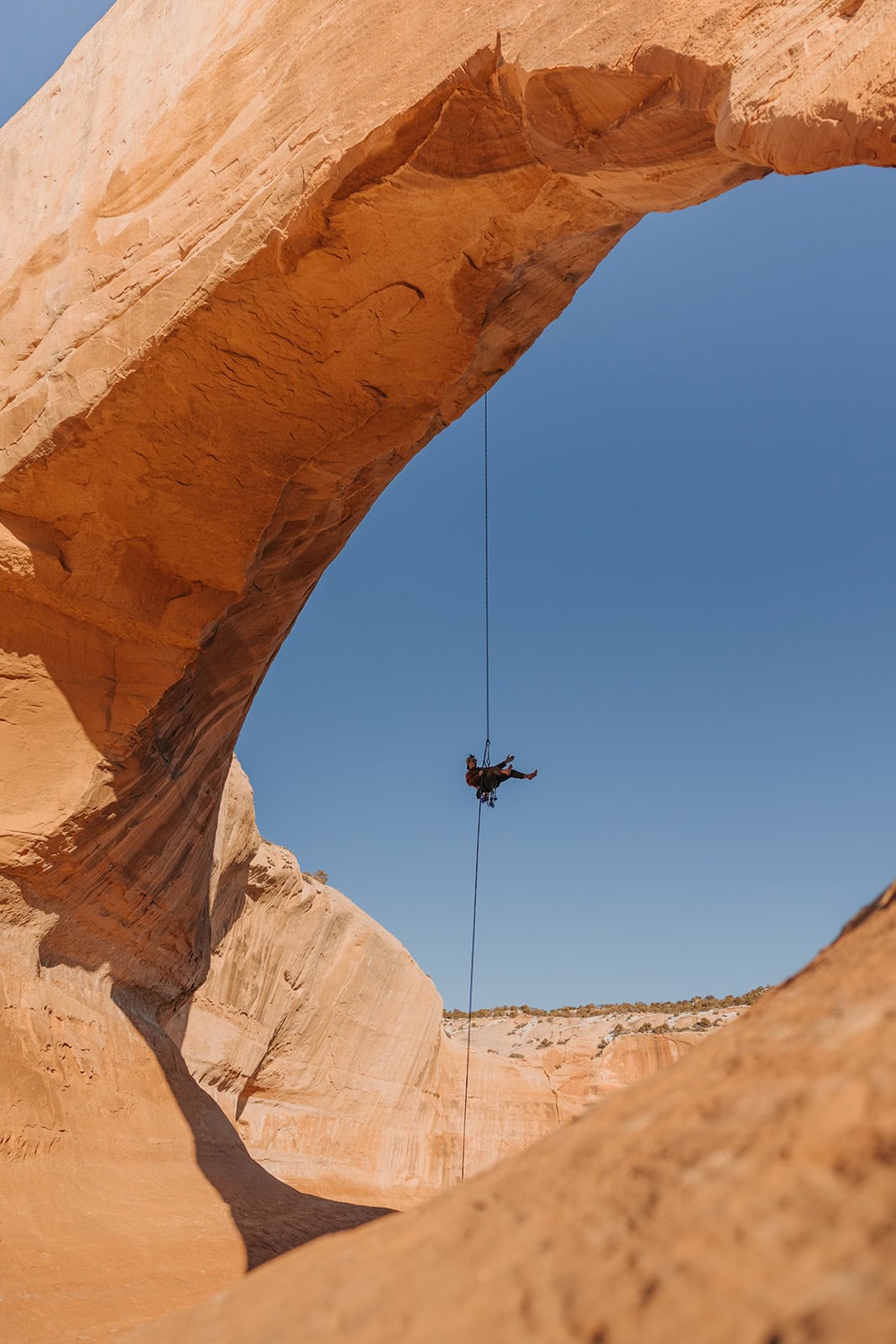
Double Arch
After the spectacular sunrise at Delicate Arch, a visit to Double Arch in the Windows Section of the park is a must. This impressive formation consists of two arches sharing the same foundation for their outer legs, creating a unique and awe-inspiring sight.
Double Arch boasts some impressive statistics:
- It’s the tallest arch in the park at 112 feet (34m)
- It’s the second-longest arch, spanning 144 feet (44m)
A gently sloping, barrier-free trail leads to the base of the arches, making it accessible for most visitors. The Windows Section, where Double Arch is located, is considered by many to be the heart of Arches National Park, with a high concentration of arches in just over two square miles.
Visitors can marvel at the unique formation of Double Arch, created by downward water erosion rather than side-to-side erosion like many other arches in the park. The surrounding area also offers views of other notable features such as North Window and Turret Arch, providing a fitting end to a day filled with natural wonders.
Parking fills up very quickly here as well, but we’ve never had a problem waiting 5 or 10 minutes for a spot to open up.
Check out the Link for the Double Arch Trail here!
Park Avenue Trail
After enjoying the beauty of the windows section, visitors can head to the Park Avenue Trail, one of the first major attractions upon entering the park. This one-mile trail offers a perfect introduction to the park’s unique geology and stunning rock formations.
Key features of the Park Avenue Trail include:
- An observation deck for those who prefer not to hike
- A steep staircase leading to the valley floor
- Views of massive sandstone towers, including the Courthouse Towers
- The Tower of Babel and The Organ rock formations
The trail starts with a sandy path and transitions to a rocky base, requiring hikers to follow cairns. While relatively easy, the exposed nature of the trail means visitors should be prepared for heat and bring plenty of water.
Learn more about hiking Park Avenue Here!
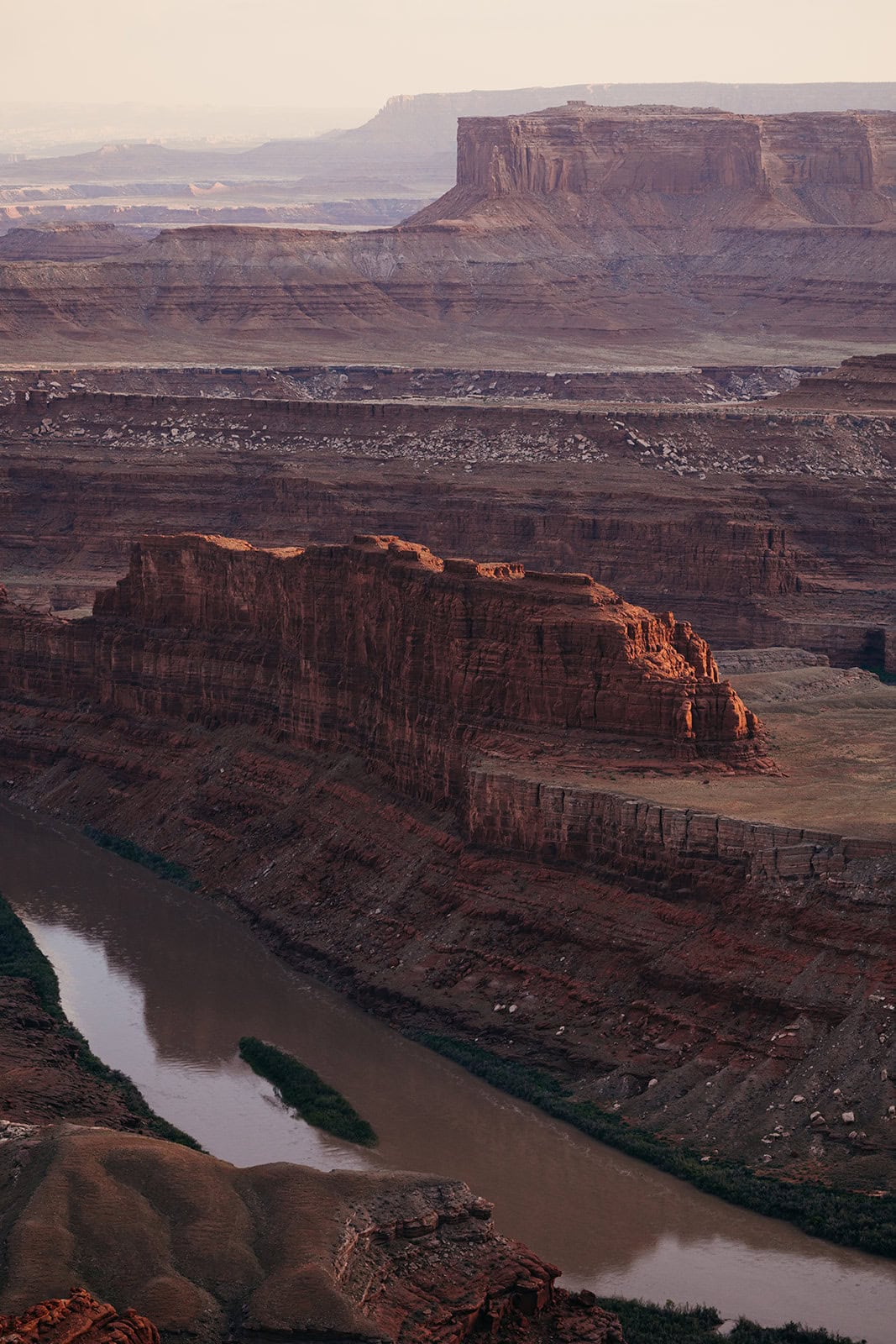
Mary Jane Canyon Hike
After an morning exploring a vast mix of stops through Arches National Park, it’s time to head out to this enchanting location.
The hike is also known as Professor Creek. It is 7.6 miles in total and an out-and-back trail. It is just under a 40-minute drive from Moab, but you drive along the Colorado River for most of it and experience stunning view after stunning view. There is a portion of driving on a road at the end, but any regular vehicle is suitable to make the drive.
As a forewarning, we do not recommend this hike if it’s cold out. But on a warm or hot day, this trail is pure heaven. Even though this hike offers little shade, you walk over and through a creek the entire time before ending at a swimming hole at the base of a waterfall.
Trail highlights:
- Water the entire hike: A great way to cool off on a hot day
- Ends at a waterfall: A nook with a swimming hole between sandstone walls
- Mostly flat: at only 600 feet of elevation gain over the entire hike, you get to relax and enjoy the trail without feeling like you’re summiting a mountain.
- Dog Friendly: Unlike the National Parks, you can bring the pup along for an absolute blast!
The trail features lots of water and the occasional slick area. Hikers should be prepared with:
- Water shoes for good hiking like Chacos
- Sun protection (sunscreen, hat, and appropriate clothing)
- Snacks to stay fueled across teh average of three hours to complete the hike.
Check out the All Trails Link here!
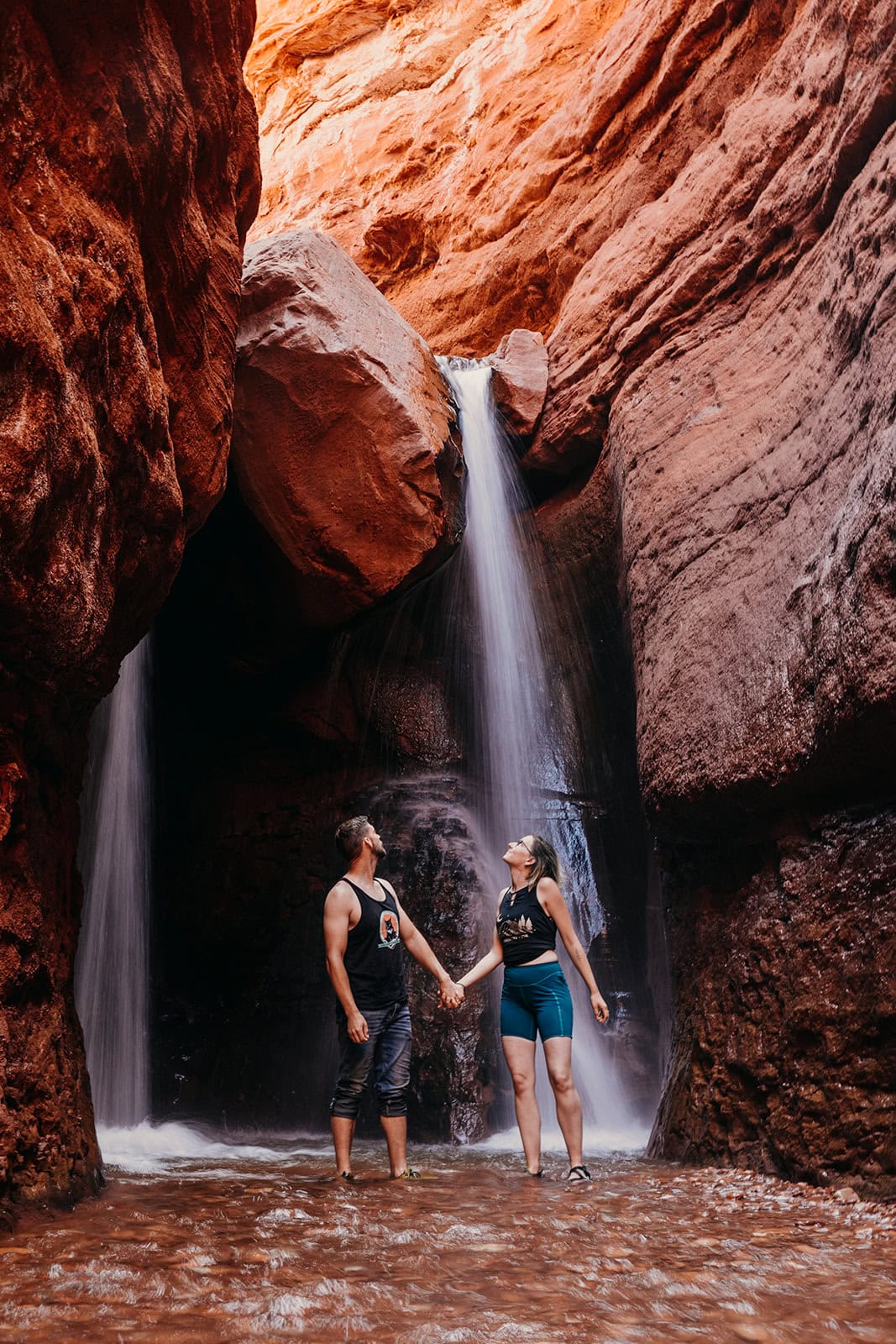
Enjoy a relaxing Sunset on the La Sal Mountain Loop Scenic Drive
After a wonderful morning exploring arches and spending the day hiking through the water, you don’t want to miss the incredible sunset!
Begin your journey on Highway 128, affectionately known as River Road, heading towards Castle Valley. As you turn right onto La Sal Loop Rd., you’ll ascend into the stunning Manti-La Sal National Forest. This 60-mile scenic loop takes you on a mesmerizing ride, culminating at Ken’s Lake.
The west-facing vistas along this route offer prime spots to witness Moab’s most spectacular sunsets. Unlike many rugged backroads in the area, this scenic drive is perfect for regular cars. However, larger vehicles like RVs and trailers might struggle with some tight turns. Before setting off on this 2-3 hour excursion, ensure your vehicle is fueled up or fully charged.
Get ready for an intimate encounter with nature, where every turn reveals a new, awe-inspiring landscape. This drive is the perfect way to bring your first night in Moab to a close.
Click here to check the road information before heading out!
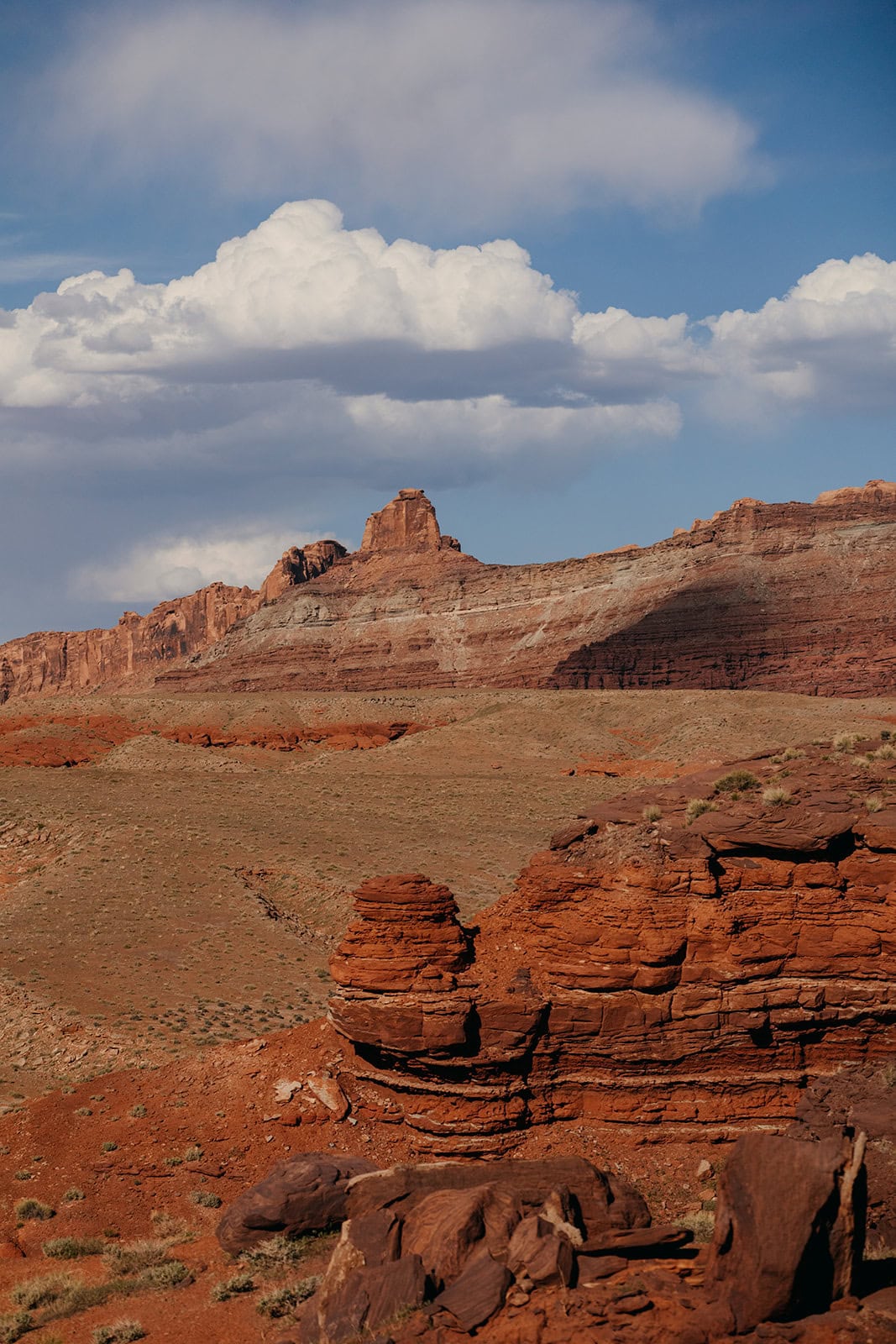
Day 2: Off-Roading and Canyon Adventures
The second day of the Moab adventure offers a thrilling mix of off-road excitement and breathtaking hikes. Visitors can experience the rugged terrain and stunning landscapes that make Moab a paradise for outdoor enthusiasts.
Hell’s Revenge 4×4 Trail
For those seeking an adrenaline rush, the Hell’s Revenge 4×4 Trail provides an unforgettable off-road experience. This 6.5-mile trail is rated a 6 by the Red-Rock Four-Wheelers, making it suitable only for experienced drivers. Thankfully, Moab has plenty of guide services like Moab Off-Road ATV Tours who will guide you through the adventure!
Key features of the Hell’s Revenge Trail include:
- Steep fins and slickrock domes
- Challenging obstacles like Hell’s Gate and Tip-Over Challenge
- Stunning views of the surrounding landscape
The trail begins just past the Sand Flats Recreation Area Entrance Station and is marked with signs and symbols painted on the rock surface. Drivers should follow the yellow chevron symbols and stay on designated roads to protect the environment.
Safety tips for the Hell’s Revenge Trail:
- Maximum speed limit is 15 mph
- Use caution when crossing the Slickrock Bike Trail
- Avoid large depressions in the rock known as potholes, except for the marked “Mickey’s Hot Tub”
- Use spotters for extremely steep descents
Learn more about visiting Sand Flats Recreation Area!
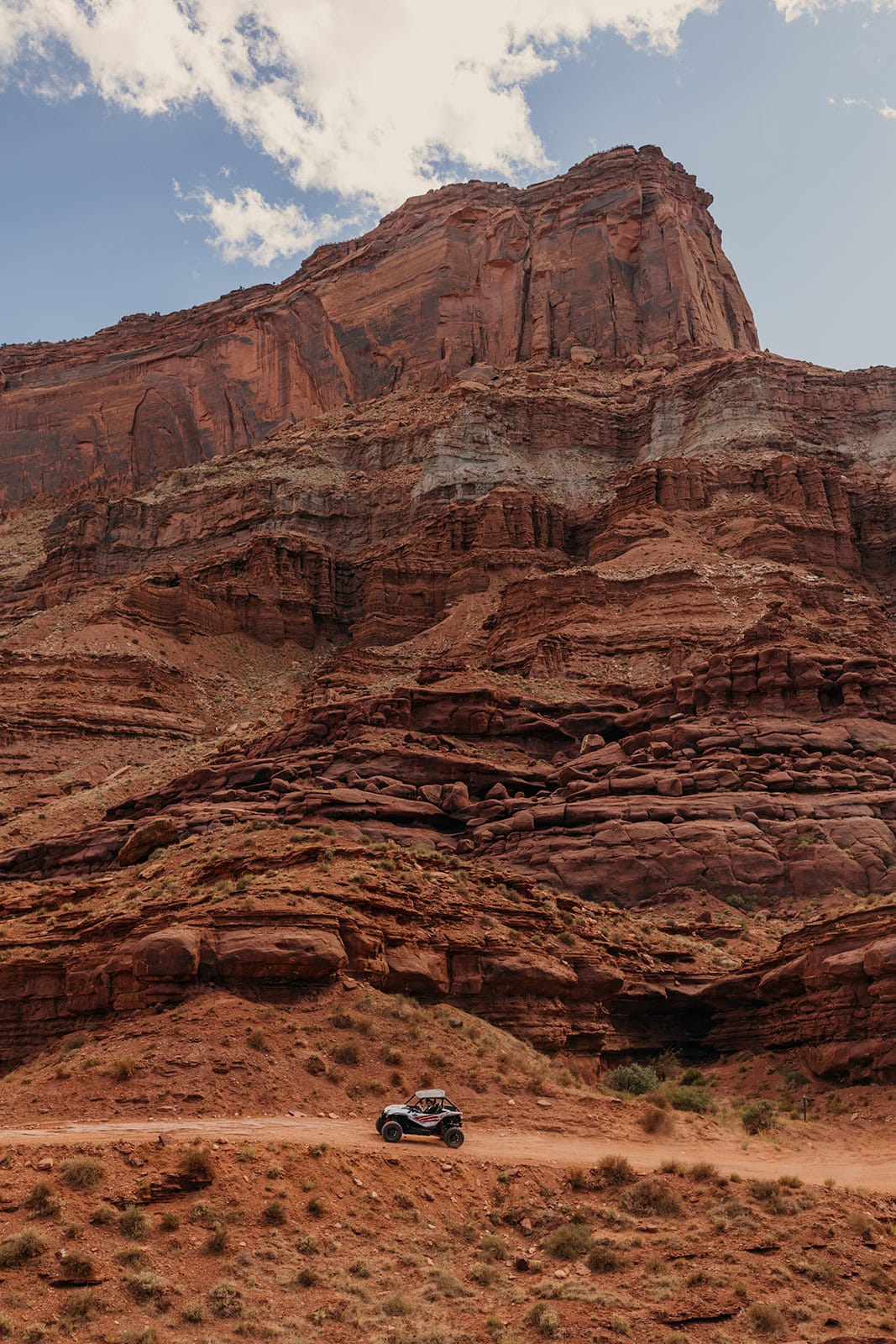
Corona Arch Hike
After the morning’s off-road adventure, hikers can explore the impressive Corona Arch. This 3-mile round-trip hike offers a chance to see one of the largest and most spectacular arches near Moab.
Trail highlights:
- Corona Arch: A 140-foot wide by 105-foot high sandstone span
- Bowtie Arch: A unique pothole arch visible along the trail
- Pinto Arch: An optional detour offering views of the Colorado River
- Dog Friendly: Another location where it’s perfect to bring the pup along!
The trail features varied terrain, including a short section of mild scrambling and safety chains. Hikers should be prepared with:
- Plenty of water
- Sun protection (sunscreen, hat, and appropriate clothing)
- Sturdy hiking boots
Check out the All Trails link here for more information!
Sunset at Dead Horse Point
To cap off an exciting day, visitors can head to Dead Horse Point State Park for a breathtaking sunset experience. This state park offers stunning views that rival those of nearby national parks.
Why Dead Horse Point is special:
- Panoramic views of the Colorado River and surrounding canyons
- Less crowded than Arches National Park for sunset viewing
- Easy access to viewpoints from the parking lot
- Another dog friendly location!
Visitors can choose to watch the sunset from the main overlook or explore the Rim Trail for various vantage points. The west side of the Rim Trail offers gorgeous overlooks, while the eastern side provides views of the La Sal Mountains.
As the day comes to a close, the changing colors of the desert landscape and the silhouette of the snow-capped La Sal Mountains (snow cap pending time of the year!) create a magical atmosphere, perfectly encapsulating the beauty of Moab’s diverse terrain.
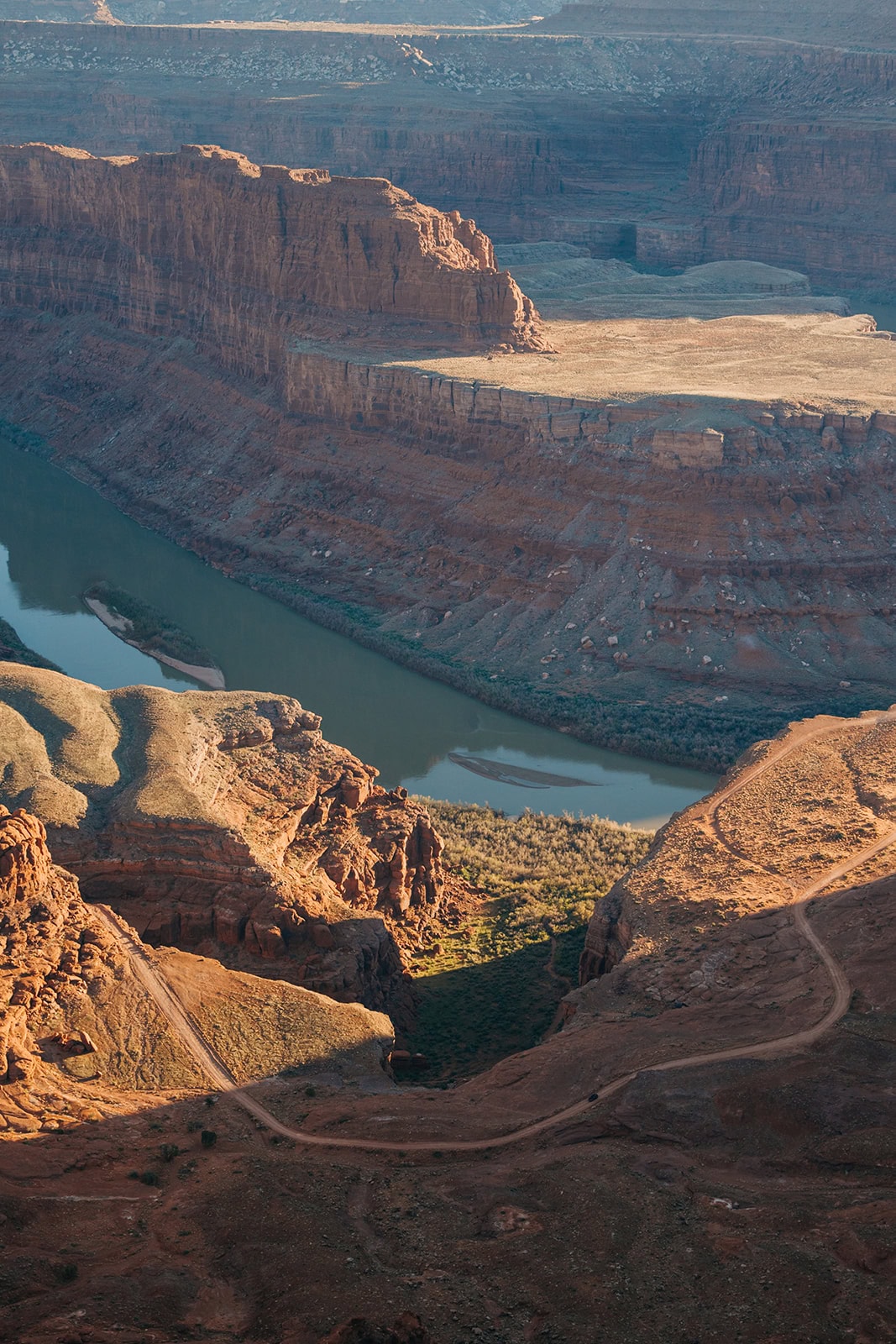
Day 3: Canyonlands National Park Exploration
The final day of the Moab adventure takes visitors to the awe-inspiring Canyonlands National Park. This vast and rugged landscape offers dramatic canyons, towering mesas, and unique geological formations that will leave nature enthusiasts in awe.
Mesa Arch at Sunrise
To start the day off right, adventurers should head to Mesa Arch for a breathtaking sunrise experience. This iconic landmark frames the distant canyons and mesas, creating a stunning natural spectacle. The best time to visit is at sunrise when the warm light illuminates the sandstone, creating a magical scene.
The Mesa Arch trail is an easy 0.6-mile (1 km) loop with up to 88 feet of elevation gain. It takes about 30 minutes to complete, but visitors should arrive at least 75-90 minutes before sunrise to secure a good spot. The trail is uneven and rocky, so proper footwear is essential.
Tips for photographing Mesa Arch:
- Use a wide-angle lens to capture the entire arch
- Set your camera to manual mode with a high f-stop to create a sunburst effect
- Enable HDR mode on smartphones for better results
Learn more about the Mesa Arch Trail.
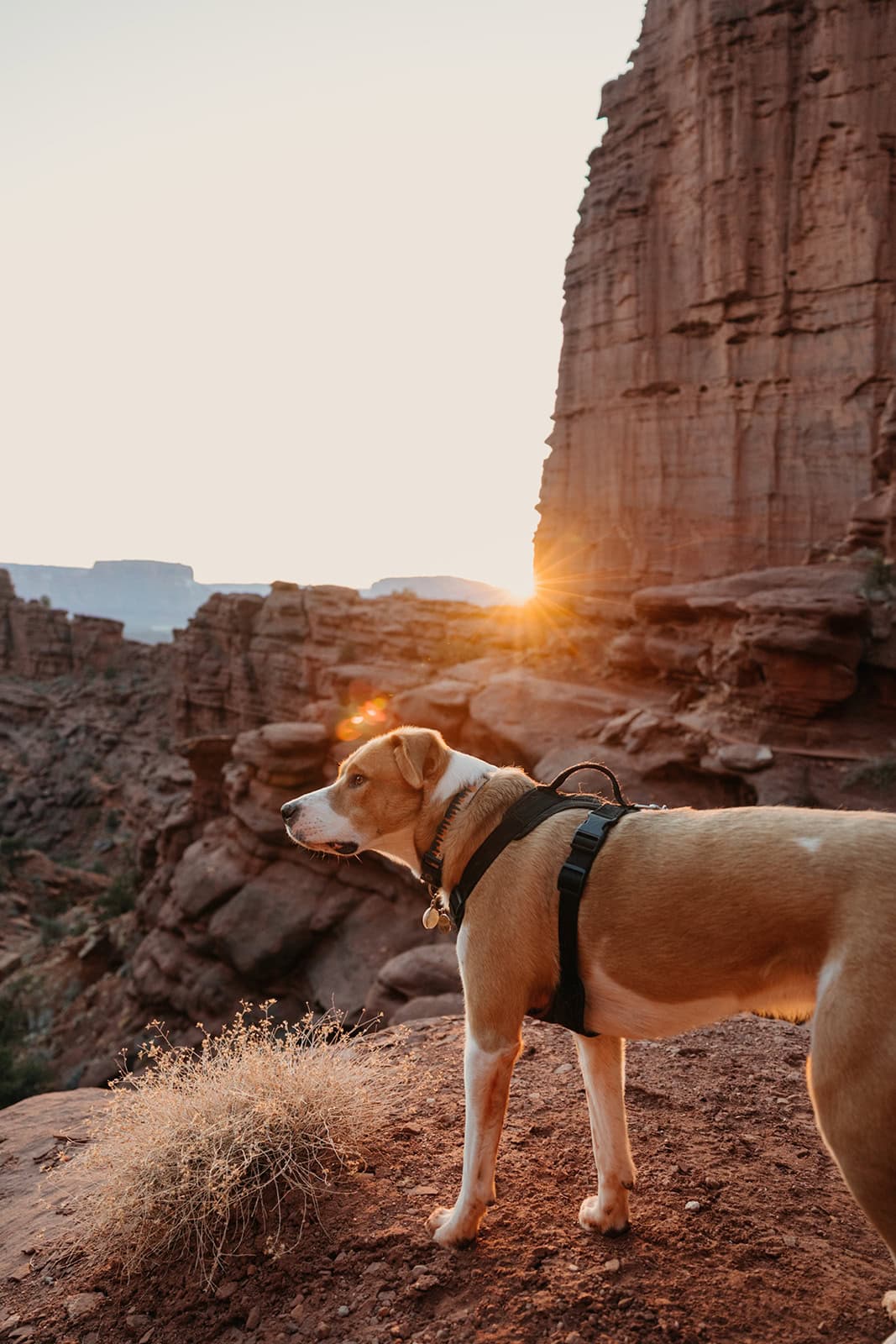
Upheaval Dome
Next, visitors can explore the mysterious Upheaval Dome, a unique geological feature that has puzzled scientists for decades. This three-mile-wide crater showcases dramatically deformed rock layers, with a central dome surrounded by a downward-warping syncline.
Two main theories explain the formation of Upheaval Dome:
- Salt dome theory: A thick layer of salt beneath the surface flowed upward, deforming the overlying rock layers.
- Meteorite impact theory: A meteorite collision about 60 million years ago created an unstable crater that partially collapsed and then rebounded.
Recent research supports the meteorite hypothesis, but the mystery remains unsolved, making Upheaval Dome a fascinating subject for geology enthusiasts.
Learn more about visiting Upheaval Dome here.
Shafer Trail Road on the way back to town
To cap off the Canyonlands experience, visitors should head to the Shafer Trail Road. This road offers panoramic views of the park’s vast canyons and an amazing experience as you wind down Shafer Trail, a historic road that descends 1,500 feet down sandstone cliff walls.
The Shafer Trail is easily accessible (but 4×4 is required) and is a knock-your-socks-off combination of views and experience around every turn. As a much needed bonus and among the many stops you’re sure to make on the way down, be sure to stop at Thelma and Louis Point.
The 19-mile Shafer Canyon Road offers an exciting off-road experience. However, it’s important to note:
- High-clearance 4WD vehicles are strongly recommended
- Check weather and road conditions before attempting the drive
- Obey the 15 mph speed limit and stay on the designated trail
As visitors take in the breathtaking views from the Shafer Trail Road, they’ll gain a deeper appreciation for the park’s incredible natural beauty and geological wonders.
Be sure to know road conditions for Shafer Trail Road before heading out.
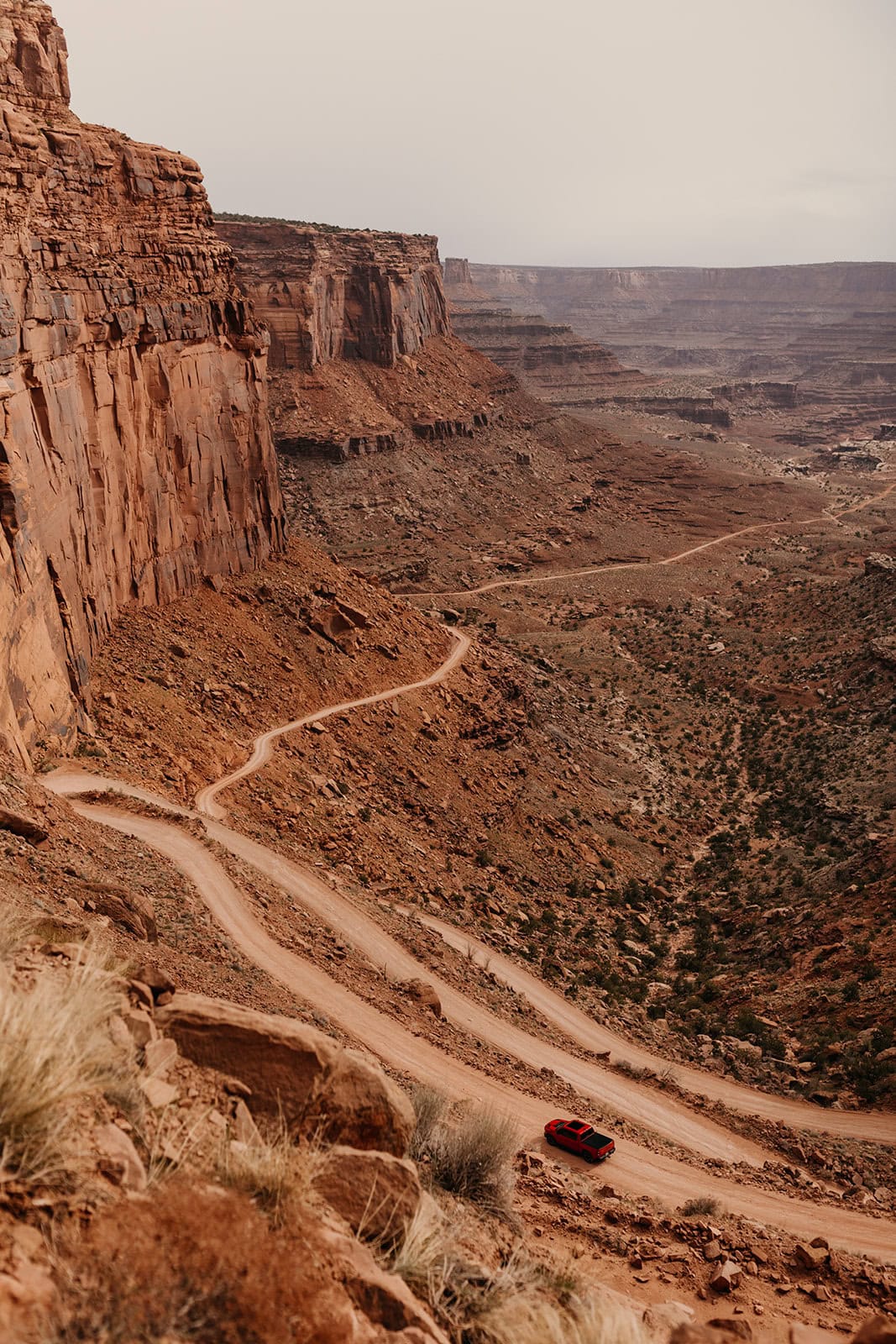
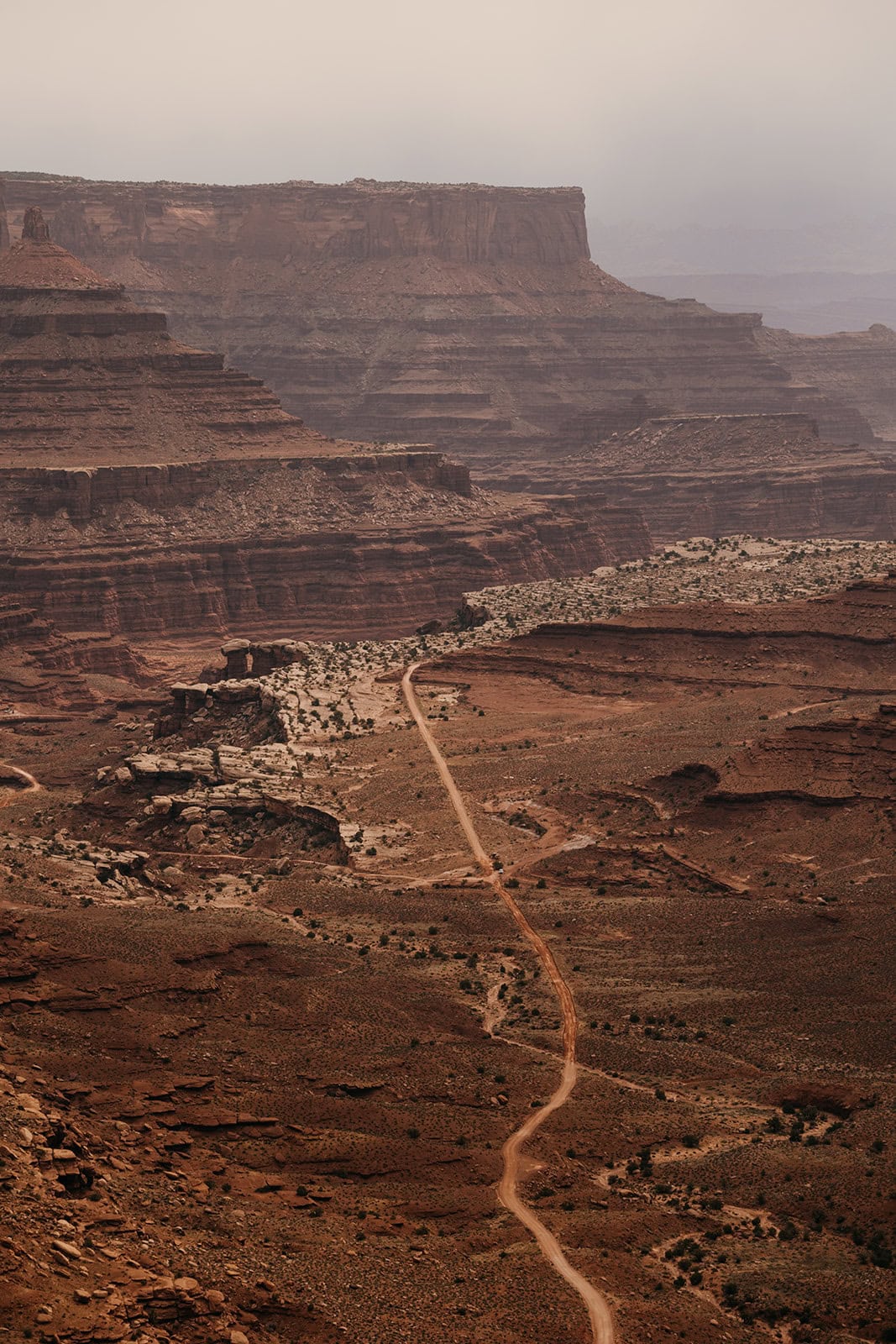
Float the Colorado River
At this point, you’ve watched the sunrise through multiple arches, marveled in awe as it set over the mountains in the distance, off-roaded through slick rock trails and canyon corridors, and hiked to stunning locations in between. There is still one more activity that is a common thrill for many visitors to the area, and that’s floating down the Colorado River!
Mild to Wild Rafting and Jeep Tours is one of many companies in the area that can provide you with a drop-off and pickup service and the raft you need for this relaxing experience.
The Top 3 reasons why Floating the Colorado River is a must:
- The scenery is unreal, and just like vista views can only be experienced from the top, the same is true for the bottom looking up.
- The river does all of the work for you. It’s the perfect blend of outdoor activity with relaxation built in.
- With the right guide company, you’ll learn so much information about the facts of the surrounding nature and how important the Colorado River is to Moab’s existence.
Moab’s Hidden Treasures
If you have extra time to spare during the longer summer hours, or maybe this three-day itinerary is just a kick-off to a week-long trip in Moab, here is a continued list of must-consider activities and stops.
While Moab’s national parks steal the spotlight, the area harbors lesser-known attractions that offer unique glimpses into the region’s prehistoric past. These hidden gems provide visitors with extraordinary experiences that bring ancient history to life.
Dinosaur Tracks
Moab’s landscape is a treasure trove of dinosaur tracks, offering a tangible connection to the Jurassic period. The Dinosaur Tracks Trail, an easy hike above the Colorado River, leads to an open-air museum featuring a tilted boulder face with preserved footprints. The largest tracks belong to the Allosaurus, a fierce predator that once roamed this area 150 million years ago.
Several accessible sites near Moab allow visitors to step back in time:
- Poison Spider Dinosaur Tracksite: Located along Potash Road, this site features a short trail with informative plaques and nearby petroglyphs.
- Bull Canyon Overlook Dinosaur Tracksite: Situated near the La Sal mountains, this location offers breathtaking views along with well-preserved tracks.
- Mill Canyon Dinosaur Tracksite: Home to some of North America’s first discovered dinosaur tracks, this site showcases a variety of prints around an ancient watering hole.
These sites not only fascinate dinosaur enthusiasts but also provide a humbling perspective on Earth’s history.
Potash Road Petroglyphs
Utah Scenic Byway 279, also known as Potash Road, is home to an impressive collection of ancient rock art. The petroglyphs and pictographs along this route date back to 6,000 B.C., offering a glimpse into the lives of early inhabitants.
Key features of the Potash Road petroglyphs include:
- Archai period carvings (at least 3,000 years old) depicting strange humanoid figures with animal features
- Fremont culture contributions (450-1300 AD) showing bighorn sheep and hunting scenes
- Ute community artwork created post-European contact, including horse riders and hunting tactics
The highway’s construction inadvertently preserved these artworks by removing the talus slope, making them harder to reach for potential vandals. However, visitors are reminded that adding marks to these ancient panels is illegal and destructive to cultural heritage.
Moab Giants Dinosaur Park
For a more interactive dinosaur experience, Moab Giants Dinosaur Park and Tracks Museum brings prehistoric creatures to life. This unique attraction combines education and entertainment, making it perfect for visitors of all ages.
Highlights of Moab Giants include:
- Dinosaur Trail: A walk featuring over 100 life-size dinosaur replicas set against Moab’s stunning backdrop
- 5-D Virtual Aquarium: An immersive experience introducing visitors to ancient marine life
- Dig It Out and Paleo Camp: Hands-on activities simulating paleontological work
- Museum displays: Showcasing original tracks and fossilized remains
The park’s location amidst Jurassic rock layers adds authenticity to the experience, allowing visitors to imagine these giants roaming the very landscape they’re exploring. With its blend of scientific accuracy and interactive elements, Moab Giants offers an engaging way to learn about the area’s prehistoric past.
Outdoor Activities Beyond Hiking
Mountain Biking
Moab is renowned as one of the best mountain biking destinations in Utah, offering a diverse range of trails for riders of all skill levels. The area’s unique landscape, characterized by red sandstone formations and slickrock terrain, provides an otherworldly backdrop for cycling adventures.
Advanced riders can test their mettle on trails like Captain Ahab, a technical singletrack built by and for experienced mountain bikers. The Klondike Bluff network, with over 50 miles of trails, caters to a wide range of abilities and offers opportunities for longer, more technical rides.
For those seeking a true adventure, the Mag 7 trail system provides a challenging experience. Riders are advised to start early, as the trail often takes longer than expected and offers little shade along the route.
Rock Climbing
Moab’s diverse geological formations make it a world-class destination for rock climbing enthusiasts. The area boasts a variety of climbing styles, from traditional crack climbing to sport routes and even bouldering too!
Wall Street, located just outside Moab, is an ideal spot for climbers of all abilities. It features mostly single-pitch routes with grades ranging from 5.5 to 5.11, offering a mix of traditional and sport climbs easily accessible from the road.
For those looking to hone their crack climbing skills, the Ice Cream Parlor in Kane Creek provides some of the best introductory crack climbs in the region. More experienced climbers often venture to Indian Creek, about an hour’s drive from Moab, known for its challenging and sustained crack climbs with grades from 5.9 to 5.14.
Meanwhile, Castle Valley, just a half-hour east of Moab, boasts majestic towers rivaling those of Devil’s Tower, including the famous Castleton Tower and Fisher Towers.
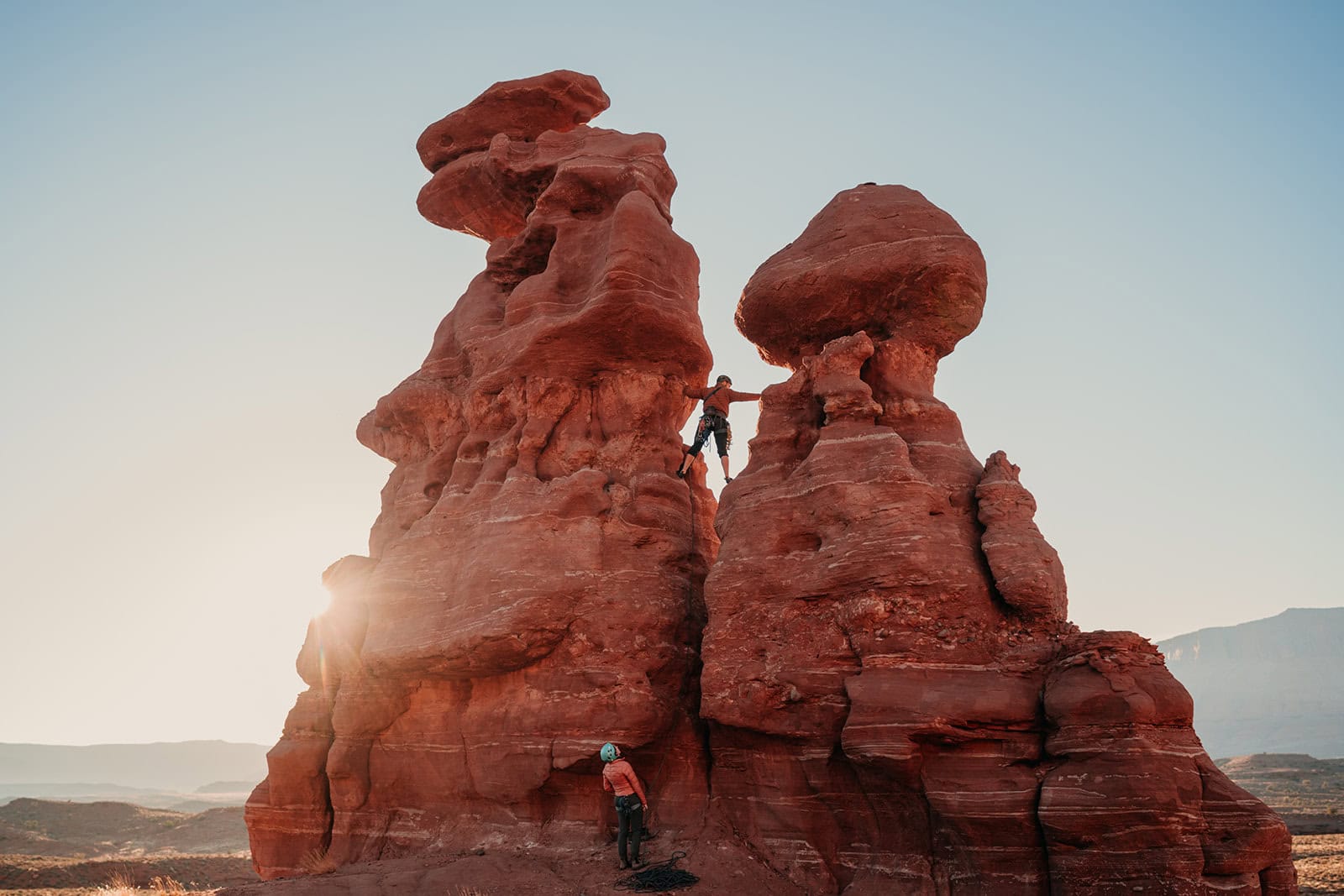
Explore the Shops on Main Street
Part of the town of many small towns is the myriad of local and unique shops that line the downtown streets and Moab is no different. Whether it be a book to read while relaxing in the midst of the desert, souvenirs to remember the trip, or gifts to share with loved ones, here are our personal 3 favorite stops right off the main strip:
- Back of Beyond Books – A great stop with lots of popular titles and a pulse on the local community. For the bibliophiles out there, they also have plenty of rare and historic books for sale
- Moab Garage Co. – We love their cute jewelry and branded merchandise. but this is also one of our favorite spots for coffee and lunch.
- Grand County Library – You may be asking, a library, really? But seriously, yes! The local library is not only an amazing resource for locals and travelers alike, but they have a resident cat named Cosmo who lives in the library. If you’re lucky, you might catch a chance to tell him hello.
Conclusion: Memories to Last a Lifetime
Moab’s captivating beauty and wealth of outdoor activities make it an ideal destination for adventurers and nature enthusiasts. From hiking in iconic national parks to exploring hidden gems like ancient rock art and dinosaur tracks, this small Utah town has something to offer for everyone. The diverse landscape provides opportunities for thrilling experiences such as off-roading, mountain biking, rock climbing, and rafting, ensuring visitors can fully immerse themselves in the stunning red rock scenery.
A three-day trip to Moab allows travelers to scratch the surface of what this remarkable area has to offer. Whether you’re marveling at the sunrise over Delicate Arch, taking in the panoramic views at Dead Horse Point, or savoring local cuisine after a day of exploration, Moab leaves a lasting impression. This desert paradise invites visitors to connect with nature, challenge themselves, and create unforgettable memories amidst some of the most breathtaking landscapes in the American Southwest.
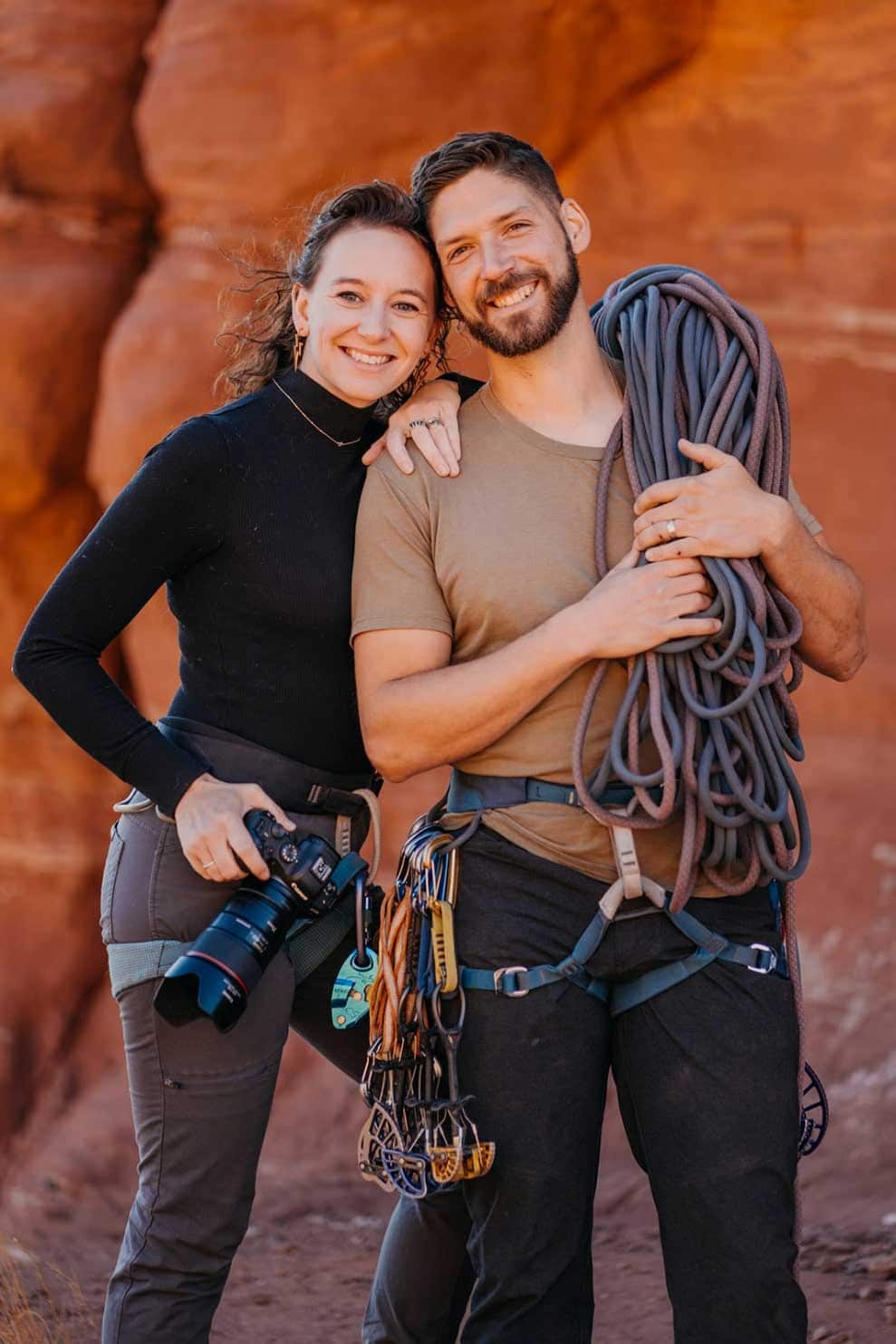
Your 3 Days in Moab Itinerary Guides
Hey there! We’re Traci and Bill. We travel all across the southwest and up through the west coast exploring town after town while capturing love stories with our elopement business Adventure and Vow.
An awesome perk on top of this awesome perk of a job is that we learn everything there is to know about the places we work in so that we’re able to best serve our eloping couples. With the wealth of knowledge we have generated from years of exploring the US, we wanted to put it together to share with others who also share the same love of travel!
FAQs
Is a three-day trip to Moab sufficient to enjoy its attractions?
Yes, three days in Moab provide ample time to explore both Arches and Canyonlands National Parks, participate in a few adventurous activities, and even take a day trip to further explore the Colorado Plateau.
What is the recommended duration for a trip to Moab to fully experience it?
For those seeking a more leisurely vacation with extensive time for outdoor activities, a week or more in Moab would be ideal. The area offers a wealth of stunning landscapes and a variety of outdoor activities, making it a prime vacation spot in Utah.
What are some recommended activities for a day trip in Moab?
A day in Moab can be eventful with activities such as rafting on the Colorado River, joining a sunset Hummer safari, engaging in half-day canyoneering, exploring Arches National Park, ziplining in Moab, hiking to Fisher Towers, driving to the overlook at Dead Horse Point, or renting a Jeep to venture into remote areas.
How much time is needed to drive through Arches National Park?
Driving through Arches National Park can take a few hours to a full day. The park’s 36-mile round-trip route offers numerous stops for photo opportunities and panoramic views, allowing visitors to appreciate the park’s stunning natural formations from the comfort of their vehicle.
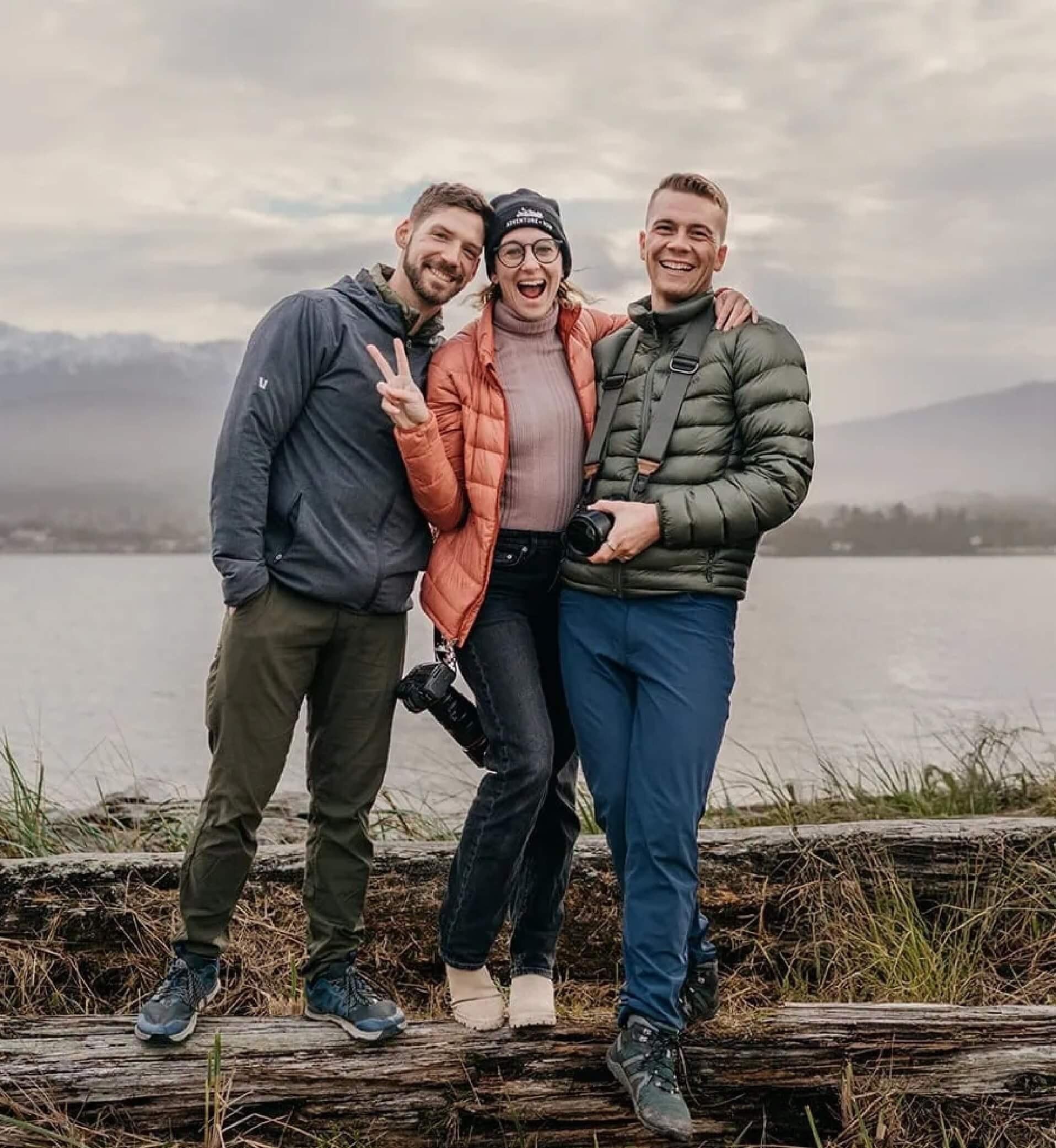
Meet your team!
Hi – it is Traci, Bill and Malachi
Over the years, we’ve helped hundreds of couples plan and document intentional, meaningful elopements in wild places.
Our blogs are where we share what we’ve learned—location guides, planning tips, real elopement stories, and advice to help you feel confident and inspired as you plan your own day.
Whether you’re just getting started or deep in the details, we’re here to support and inspire you. When you’re ready, reach out to book a free consult call and start planning your day with us.
